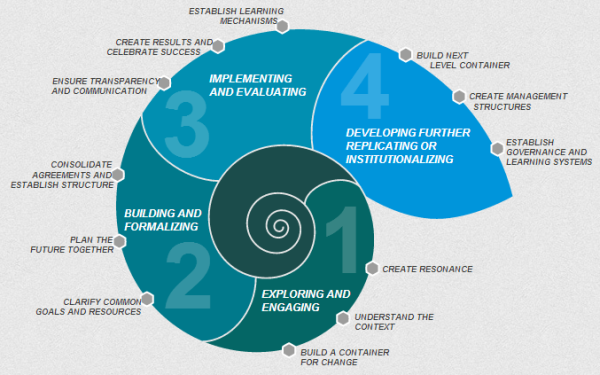
The Dialogic Change Model presents a structured way for organizations to plan and implement their stakeholder communication initiatives. It is divided into four phases: Exploring and Engaging; Building and Formalizing; Implementing and Evaluating; and Developing Further, Replicating or Institutionalizing. It was created to focus on the importance and value of dialogue between stakeholders, and is a pivot away from a top-heavy style of project management.
1. Exploring and Engaging:
In this phase, the context of the stakeholder communication is explored. What factors may influence the dialogue? Who are the primary and secondary stakeholders? What systems are in place and how might they impact stakeholder participation?
Talking to selected but relevant stakeholders and opinion-leaders informally at this point helps to understand the prospects and potential obstacles for dialogue and change.
Expected outcomes:
- Identifying stakeholders
- Building stakeholder trust
- Gaining credibility required for implementation
- Understanding the context of the project/issue with respect to stakeholders
- Identifying external influencing factors
2. Building and Formalizing:
This phase is focused on solidifying the stakeholder communication process and moving towards formal acknowledgement of stakeholder commitment. Project teams are set up, meeting schedules are developed and agreements are signed – depending on the nature of the project this could mean formal contracts, memos of understanding, project plans, etc.
The structure for the Stakeholder Dialogue needs to offer a sufficient degree of ‘process safety’ in an otherwise unpredictable and complex environment: contribution, roles and allocation of work as well as communication and process designs need to be agreed upon jointly.
Expected outcomes:
- Collaboration agreements
- Project plans
- Implementation agreements
- Formal organizational units to help guide the process i.e. committees, dedicated teams, working groups, etc.
3. Implementing and Evaluating:
This is the actual implementation phase – with the key performance indicator being “results”. For a stakeholder dialogue to be effective it must deliver on the promise of visible progress, change or benefits, or stakeholders will just lose interest in the process. During this phase organizations often recognize that specific project components or issues may have not been addressed or properly considered earlier in the process. In addition, it is common that new and/or “missed” stakeholder get introduced to a project.
The complexity of a process often becomes evident during this phase, sometimes in the form of a crisis. Crisis symptoms may include criticism from external parties, stakeholders voicing new, previously unspoken interests, negative press, counter initiatives, endless non-productive discussions, or a group of actors threatening to back out of the dialogue process. Political interests can often hold up an initiative’s development or complicate consensus-building. The more stability and trusting relationships have been created in Phase 1 and 2, the better such phases of instability can be overcome.
Expected outcomes:
- Sharing/publishing successful milestones
- Generating project implementation and status reports
- Public communication and media coverage
- Stakeholder communication monitoring system in place
4. Further Development, Replicating or Institutionalizing:
It is common for many stakeholder dialogues to end after the successful completion of phase three. However, some stakeholder communication initiatives do move on to get set up as “sustainable structures” as this fourth phase. This can take many forms including replication of programs at other locations or across multiple projects or formalizing the stakeholder dialogue process within the organization.
The major challenge in Phase 4 is keeping the spirit of change alive. The move from a more loosely structured initiative to an institution is not necessarily an easy process. Replication or institutionalization often requires a professional management structure. Roles change and decision-making structures have to become more efficient. Existing management structures require additional legitimacy and credibility. Therefore, it is recommended that the original core group remains actively involved in Phase 4 of a Stakeholder Dialogue, progressively handing over their function to new actors and transferring the process step by step into its future structure.
Expected outcomes:
- Ongoing stakeholder participation
- Setting extended objectives
- Institutionalizing the stakeholder communication program
- Leveraging the dialogue experience and using it to inform other processes or projects
Learn how our stakeholder management software can help your organization effectively connect and communicate with important audiences across the communities in which you operate. Request a StakeTracker Demo.

Leave a Reply